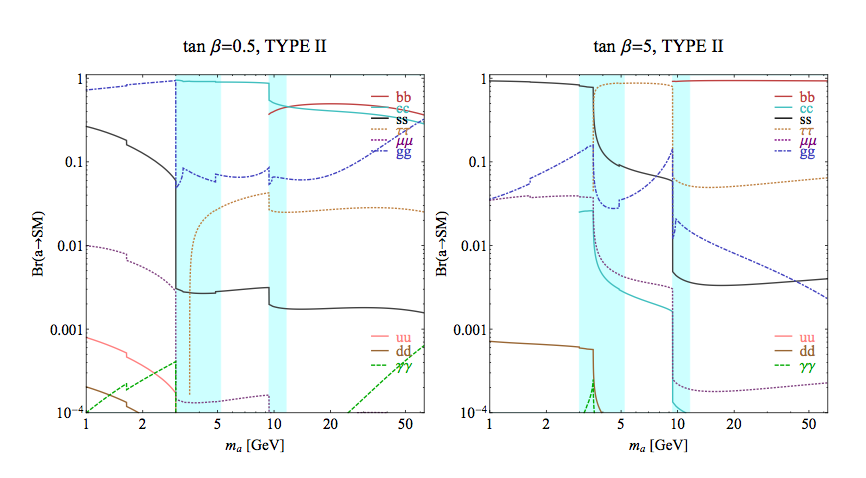Two Higgs-doublet models (2HDM) consisting of two Higgs fields are a particularly simple extension of the SM, which can be found in many well-motivated theories. Adding a scalar singlet to a 2HDM provides a wealth of possible exotic Higgs decays. A comprehensive review of 2HDM can be found in [1], while for a shorter summary we refer the reader to Section 1.3.2 of arXiv:1312.4992.
The phenomenology of the 2HDM models is generally dictated by two parameters : tanβ = v2/v1 (v1, v2 are vacuum expectation values of the Higgs doublets) and the rotation angle α that defines the scalar mass eigenstates in terms of the real components of the doublets. To avoid large Flavor-Changing Neutral Currents (FCNCs), Z2 symmetries can be imposed to ensure that fermions with the same quantum numbers all couple to only one Higgs field. This results in four "standard" types of fermion couplings commonly discussed in the literature (see Section 1.3.2 and Table II of arXiv:1312.4992).
One real mass eigenstate, h, is identified as the ∼ 125 GeV SM-like Higgs, while other states of the 2HDM are taken to be heavy. This is easily achieved in the decoupling limit,
![]()
Under these simple assumptions, exotic Higgs decays of the form
![]()
![]()
To incorporate the already analyzed constraints on 2HDM's into the 2HDM+S (e.g. [4]), one can imagine adding a decoupled singlet sector to a 2HDM with α, β chosen so as to not yet be excluded. The real and imaginary components of S can be given separate masses, and small mixings to the 2HDM sector can then be introduced as a perturbation. Approximately the same constraints on α, β apply to this 2HDM+S, as long as Br(h → ss/aa/Za) <~10%. This allows for a wide range of possible exotic Higgs decays. There are some important differences depending on 1) whether the lightest singlet state with a mass below mh/2 is scalar or pseudo scalar 2) whether the lightest singlet state mass is above or below chiral symmetry breaking scale, which are discussed in detail in Section 1.3.2 and Appendix A of arXiv:1312.4992, respectively. The relevant branching ratio calculations are also given in Appendix A of the same document. To illustrate the rich decay phenomenology of 2HDM+S models, we plot below the branching ratios of a pseudoscalar to SM particles in Fig. 1 and Fig. 2 for Type II and Type III (lepton-specific) 2HDM+S models, respectively.

Figure 1: Branching ratios of a singlet-like pseudoscalar in the 2HDM+S for Type II Yukawa couplings. Decays to quarkonia likely invalidate our simple calculations in the shaded regions.

Figure 2: Branching ratios of a singlet-like pseudoscalar in the 2HDM+S for Type III Yukawa couplings. Decays to quarkonia likely invalidate our simple calculations in the shaded regions.
MadGraph Model
We have constructed a validated MadGraph 5 model for the SM + vector + dark higgs scenario outlined here. Taking kinetic mixing to zero reduces this model to the SM+S scenario. This can be used for signal generation in experimental and phenomenological studies in the 2HDM+S model as well, by a simple rescaling of exotic branching ratios.References
- [1]G. Branco, P. Ferreira, L. Lavoura, M. Rebelo, M. Sher, et. al., Theory and phenomenology of two-Higgs-doublet models, Phys.Rept. 516 (2012) 1-102, [arXiv:1106.0034].
- [2]J. Gunion, B. Grzadkowski, H. Haber, and J. Kalinowski, LEP limits on CP violating nonminimal Higgs sectors, Phys.Rev.Lett. 79 (1997) 982-985, [hep-ph/9704410].
- [3]G. Belanger, B. Dumont, U. Ellwanger, J. Gunion, and S. Kraml, Global fit to Higgs signal strengths and couplings and implications for extended Higgs sectors, [arXiv:1306.2941].
- [4]C.-Y. Chen and S. Dawson, Exploring Two Higgs Doublet Models Through Higgs Production, [arXiv:1301.0309].
File translated from TEX by TTH, version 4.03. On 18 Dec 2013, 14:17.